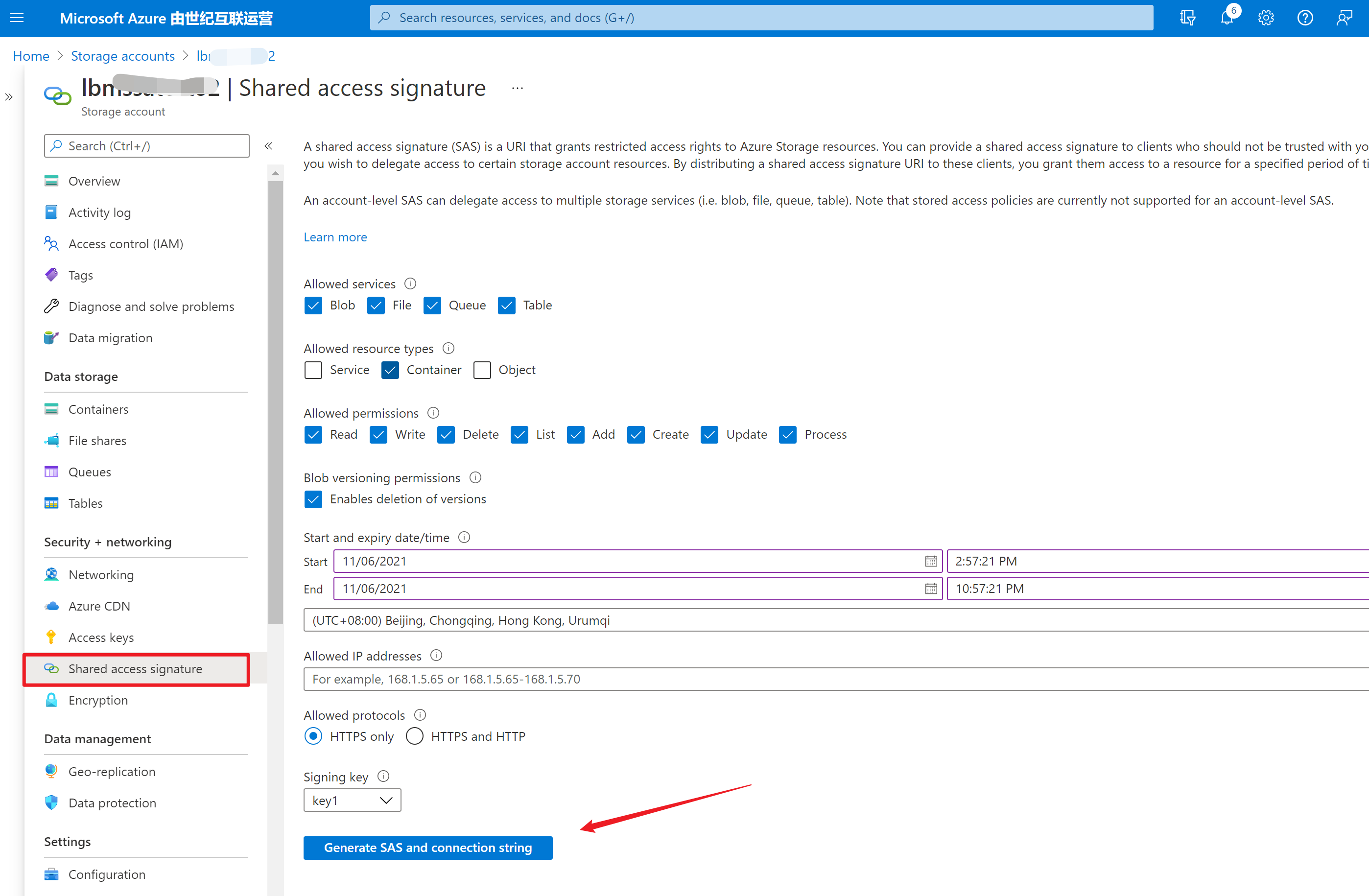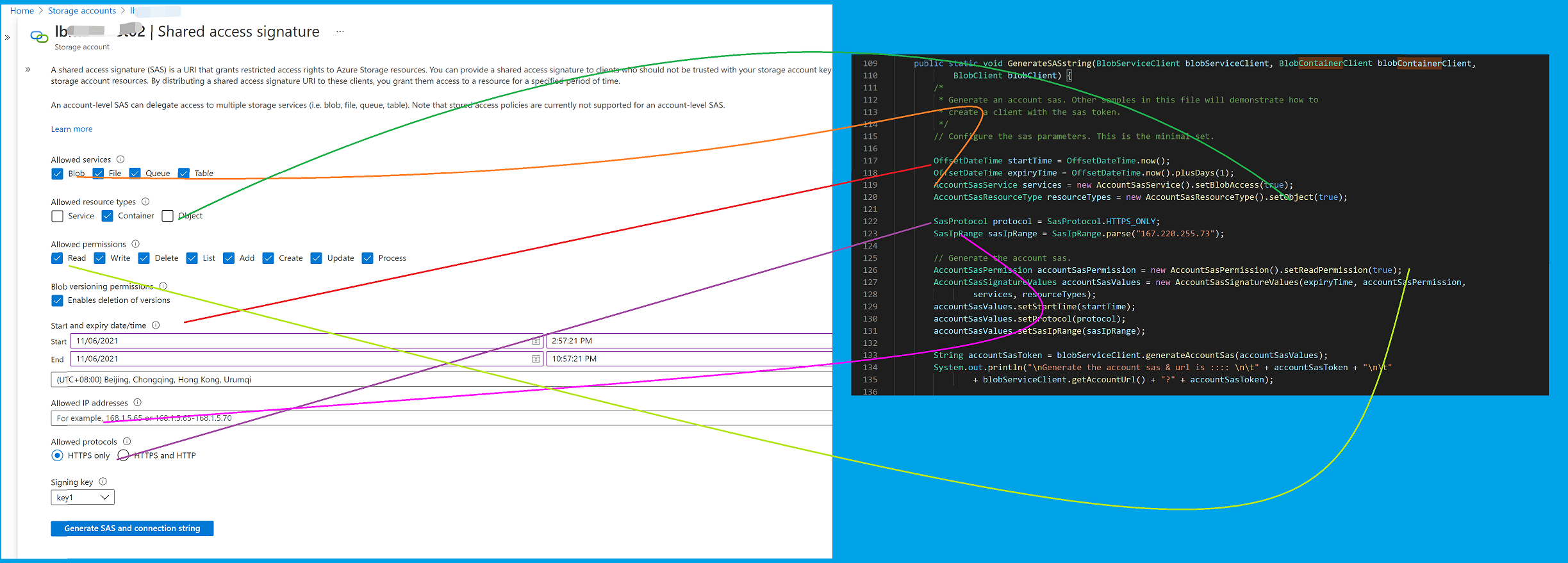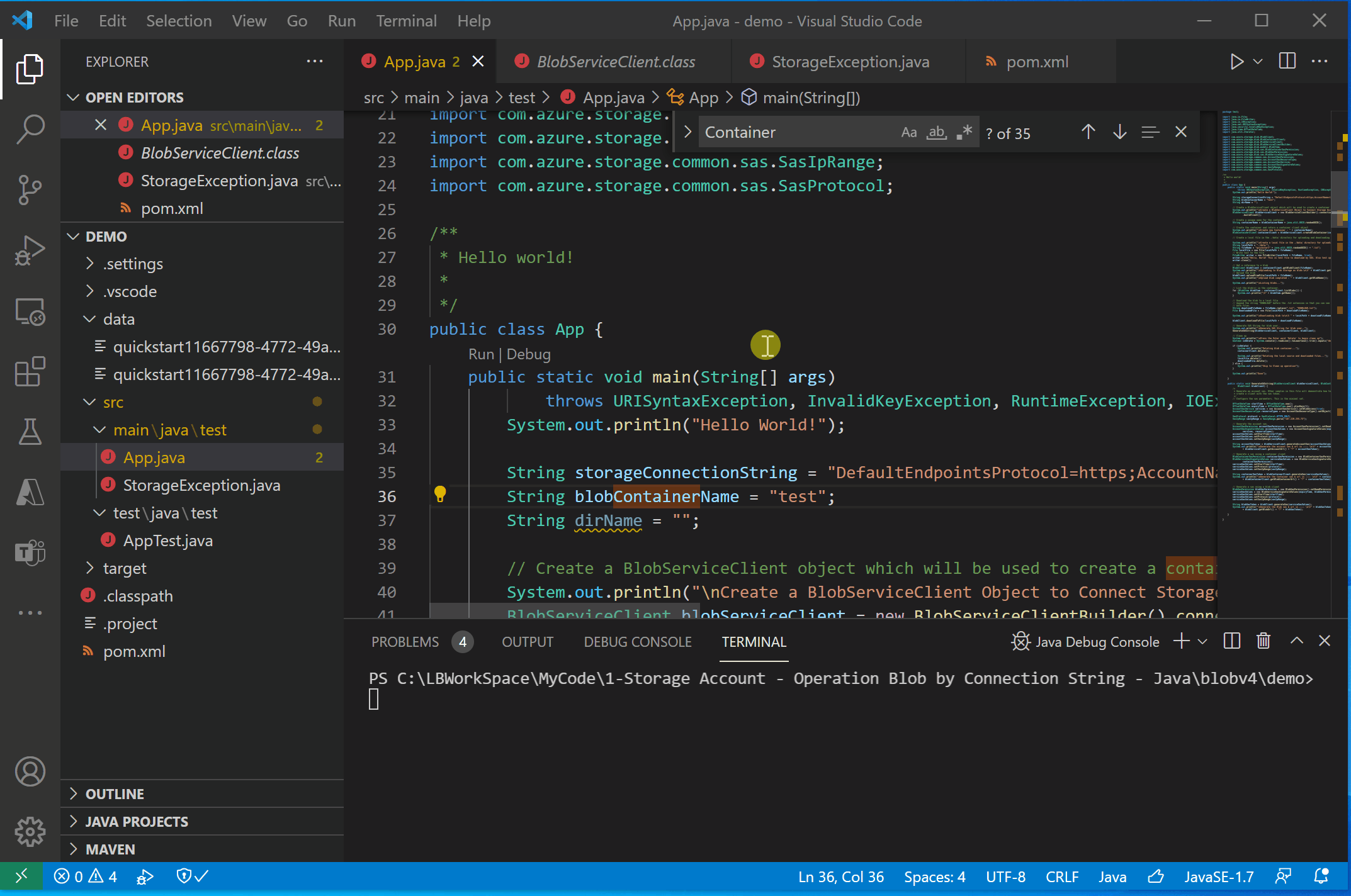【Azure 存储服务】代码版 Azure Storage Blob 生成 SAS (Shared Access Signature: 共享访问签名)
问题描述
在使用Azure存储服务,为了有效的保护Storage的Access Keys。可以使用另一种授权方式访问资源(Shared Access Signature: 共享访问签名), 它的好处可以控制允许访问的IP,过期时间,权限 和 服务 等。Azure门户上提供了对Account级,Container级,Blob级的SAS生成服务。

那么使用代码如何来生成呢?
问题回答
以最常见的两种代码作为示例:.NET 和 Java
.NET
Blob SAS 将使用帐户访问密钥(Storage Account Key1 or Key2)进行签名。 使用 StorageSharedKeyCredential 类创建用于为 SAS 签名的凭据。 新建 BlobSasBuilder 对象,并调用 ToSasQueryParameters 以获取 SAS 令牌字符串。官方文档(https://docs.azure.cn/zh-cn/storage/blobs/sas-service-create?tabs=dotnet)中进行了详细介绍,直接使用以下部分代码即可生成Blob的SAS URL。
private static Uri GetServiceSasUriForBlob(BlobClient blobClient,
string storedPolicyName = null)
{
// Check whether this BlobClient object has been authorized with Shared Key.
if (blobClient.CanGenerateSasUri)
{
// Create a SAS token that's valid for one hour.
BlobSasBuilder sasBuilder = new BlobSasBuilder()
{
BlobContainerName = blobClient.GetParentBlobContainerClient().Name,
BlobName = blobClient.Name,
Resource = "b"
}; if (storedPolicyName == null)
{
sasBuilder.ExpiresOn = DateTimeOffset.UtcNow.AddHours(1);
sasBuilder.SetPermissions(BlobSasPermissions.Read |
BlobSasPermissions.Write);
}
else
{
sasBuilder.Identifier = storedPolicyName;
} Uri sasUri = blobClient.GenerateSasUri(sasBuilder);
Console.WriteLine("SAS URI for blob is: {0}", sasUri);
Console.WriteLine(); return sasUri;
}
else
{
Console.WriteLine(@"BlobClient must be authorized with Shared Key
credentials to create a service SAS.");
return null;
}
}
JAVA
而Java的示例代码在官网中并没有介绍,所以本文就Java生成SAS的代码进行讲解。
从Java新版的SDK(azure-storage-blob)中 ,可以发现 BlobServiceClient,BlobContainerClient ,BlobClient 对象中都包含 generateAccountSas 或 generateSas 方法来实现对Account, Container,Blob进行SAS Token生成,只需要根据它所需要的参数对
public static void GenerateSASstring(BlobServiceClient blobServiceClient, BlobContainerClient blobContainerClient,
BlobClient blobClient) {
/*
* Generate an account sas. Other samples in this file will demonstrate how to
* create a client with the sas token.
*/
// Configure the sas parameters. This is the minimal set. OffsetDateTime startTime = OffsetDateTime.now();
OffsetDateTime expiryTime = OffsetDateTime.now().plusDays(1);
AccountSasService services = new AccountSasService().setBlobAccess(true);
AccountSasResourceType resourceTypes = new AccountSasResourceType().setObject(true); SasProtocol protocol = SasProtocol.HTTPS_ONLY;
SasIpRange sasIpRange = SasIpRange.parse("167.220.255.73"); // Generate the account sas.
AccountSasPermission accountSasPermission = new AccountSasPermission().setReadPermission(true);
AccountSasSignatureValues accountSasValues = new AccountSasSignatureValues(expiryTime, accountSasPermission,
services, resourceTypes);
accountSasValues.setStartTime(startTime);
accountSasValues.setProtocol(protocol);
accountSasValues.setSasIpRange(sasIpRange); String accountSasToken = blobServiceClient.generateAccountSas(accountSasValues);
System.out.println("\nGenerate the account sas & url is :::: \n\t" + accountSasToken + "\n\t"
+ blobServiceClient.getAccountUrl() + "?" + accountSasToken); // Generate a sas using a container client
BlobContainerSasPermission containerSasPermission = new BlobContainerSasPermission().setCreatePermission(true);
BlobServiceSasSignatureValues serviceSasValues = new BlobServiceSasSignatureValues(expiryTime,
containerSasPermission);
serviceSasValues.setStartTime(startTime);
serviceSasValues.setProtocol(protocol);
serviceSasValues.setSasIpRange(sasIpRange); String containerSasToken = blobContainerClient.generateSas(serviceSasValues);
System.out.println("\nGenerate the Container sas & url is :::: \n\t" + containerSasToken + "\n\t"
+ blobContainerClient.getBlobContainerUrl() + "?" + containerSasToken); // Generate a sas using a blob client
BlobSasPermission blobSasPermission = new BlobSasPermission().setReadPermission(true);
serviceSasValues = new BlobServiceSasSignatureValues(expiryTime, blobSasPermission);
serviceSasValues.setStartTime(startTime);
serviceSasValues.setProtocol(protocol);
serviceSasValues.setSasIpRange(sasIpRange); String blobSasToken = blobClient.generateSas(serviceSasValues);
System.out.println("\nGenerate the Blob sas & url is :::: \n\t" + blobSasToken + "\n\t"
+ blobClient.getBlobUrl() + "?" + blobSasToken); }
在pom.xml 中所需要加载的依赖项:
<dependency>
<groupId>com.azure</groupId>
<artifactId>azure-storage-blob</artifactId>
<version>12.13.0</version>
</dependency>
以上代码中的各部分设置项 与 Azure门户上设置项的对应关系如下图:

运行效果图

附录一:Java Main函数全部代码:
package test; import java.io.File;
import java.io.FileWriter;
import java.io.IOException;
import java.net.URISyntaxException;
import java.security.InvalidKeyException;
import java.time.OffsetDateTime;
import java.util.Iterator; import com.azure.storage.blob.BlobClient;
import com.azure.storage.blob.BlobContainerClient;
import com.azure.storage.blob.BlobServiceClient;
import com.azure.storage.blob.BlobServiceClientBuilder;
import com.azure.storage.blob.models.BlobItem;
import com.azure.storage.blob.sas.BlobContainerSasPermission;
import com.azure.storage.blob.sas.BlobSasPermission;
import com.azure.storage.blob.sas.BlobServiceSasSignatureValues;
import com.azure.storage.common.sas.AccountSasPermission;
import com.azure.storage.common.sas.AccountSasResourceType;
import com.azure.storage.common.sas.AccountSasService;
import com.azure.storage.common.sas.AccountSasSignatureValues;
import com.azure.storage.common.sas.SasIpRange;
import com.azure.storage.common.sas.SasProtocol; /**
* Hello world!
*
*/
public class App {
public static void main(String[] args)
throws URISyntaxException, InvalidKeyException, RuntimeException, IOException {
System.out.println("Hello World!"); String storageConnectionString = "DefaultEndpointsProtocol=https;AccountName=<your storage account name>;AccountKey=**************************;EndpointSuffix=core.chinacloudapi.cn";
String blobContainerName = "test";
String dirName = ""; // Create a BlobServiceClient object which will be used to create a container
System.out.println("\nCreate a BlobServiceClient Object to Connect Storage Account");
BlobServiceClient blobServiceClient = new BlobServiceClientBuilder().connectionString(storageConnectionString)
.buildClient(); // Create a unique name for the container
String containerName = blobContainerName + java.util.UUID.randomUUID(); // Create the container and return a container client object
System.out.println("\nCreate new Container : " + containerName);
BlobContainerClient containerClient = blobServiceClient.createBlobContainer(containerName); // Create a local file in the ./data/ directory for uploading and downloading System.out.println("\nCreate a local file in the ./data/ directory for uploading and downloading");
String localPath = "./data/";
String fileName = "quickstart" + java.util.UUID.randomUUID() + ".txt";
File localFile = new File(localPath + fileName);
// Write text to the file
FileWriter writer = new FileWriter(localPath + fileName, true);
writer.write("Hello, World! This is test file to download by SAS. Also test upload");
writer.close(); // Get a reference to a blob
BlobClient blobClient = containerClient.getBlobClient(fileName);
System.out.println("\nUploading to Blob storage as blob:\n\t" + blobClient.getBlobUrl());
// Upload the blob
blobClient.uploadFromFile(localPath + fileName);
System.out.println("\nUpload blob completed : " + blobClient.getBlobName()); System.out.println("\nListing blobs..."); // List the blob(s) in the container.
for (BlobItem blobItem : containerClient.listBlobs()) {
System.out.println("\t" + blobItem.getName());
} // Download the blob to a local file
// Append the string "DOWNLOAD" before the .txt extension so that you can see
// both files.
String downloadFileName = fileName.replace(".txt", "DOWNLOAD.txt");
File downloadedFile = new File(localPath + downloadFileName); System.out.println("\nDownloading blob to\n\t " + localPath + downloadFileName); blobClient.downloadToFile(localPath + downloadFileName); // Generate SAS String for blob user..
System.out.println("\nGenerate SAS String for blob user..");
GenerateSASstring(blobServiceClient, containerClient, blobClient); // Clean up
System.out.println("\nPress the Enter word 'Delete' to begin clean up");
boolean isDelete = System.console().readLine().toLowerCase().trim().equals("delete"); if (isDelete) {
System.out.println("Deleting blob container...");
containerClient.delete(); System.out.println("Deleting the local source and downloaded files...");
localFile.delete();
downloadedFile.delete();
} else {
System.out.println("Skip to Clean up operation");
} System.out.println("Done"); } public static void GenerateSASstring(BlobServiceClient blobServiceClient, BlobContainerClient blobContainerClient,
BlobClient blobClient) {
/*
* Generate an account sas. Other samples in this file will demonstrate how to
* create a client with the sas token.
*/
// Configure the sas parameters. This is the minimal set. OffsetDateTime startTime = OffsetDateTime.now();
OffsetDateTime expiryTime = OffsetDateTime.now().plusDays(1);
AccountSasService services = new AccountSasService().setBlobAccess(true);
AccountSasResourceType resourceTypes = new AccountSasResourceType().setObject(true); SasProtocol protocol = SasProtocol.HTTPS_ONLY;
SasIpRange sasIpRange = SasIpRange.parse("167.220.255.73"); // Generate the account sas.
AccountSasPermission accountSasPermission = new AccountSasPermission().setReadPermission(true);
AccountSasSignatureValues accountSasValues = new AccountSasSignatureValues(expiryTime, accountSasPermission,
services, resourceTypes);
accountSasValues.setStartTime(startTime);
accountSasValues.setProtocol(protocol);
accountSasValues.setSasIpRange(sasIpRange); String accountSasToken = blobServiceClient.generateAccountSas(accountSasValues);
System.out.println("\nGenerate the account sas & url is :::: \n\t" + accountSasToken + "\n\t"
+ blobServiceClient.getAccountUrl() + "?" + accountSasToken); // Generate a sas using a container client
BlobContainerSasPermission containerSasPermission = new BlobContainerSasPermission().setCreatePermission(true);
BlobServiceSasSignatureValues serviceSasValues = new BlobServiceSasSignatureValues(expiryTime,
containerSasPermission);
serviceSasValues.setStartTime(startTime);
serviceSasValues.setProtocol(protocol);
serviceSasValues.setSasIpRange(sasIpRange); String containerSasToken = blobContainerClient.generateSas(serviceSasValues);
System.out.println("\nGenerate the Container sas & url is :::: \n\t" + containerSasToken + "\n\t"
+ blobContainerClient.getBlobContainerUrl() + "?" + containerSasToken); // Generate a sas using a blob client
BlobSasPermission blobSasPermission = new BlobSasPermission().setReadPermission(true);
serviceSasValues = new BlobServiceSasSignatureValues(expiryTime, blobSasPermission);
serviceSasValues.setStartTime(startTime);
serviceSasValues.setProtocol(protocol);
serviceSasValues.setSasIpRange(sasIpRange); String blobSasToken = blobClient.generateSas(serviceSasValues);
System.out.println("\nGenerate the Blob sas & url is :::: \n\t" + blobSasToken + "\n\t"
+ blobClient.getBlobUrl() + "?" + blobSasToken); } }
参考资料
快速入门:使用 Java v12 SDK 管理 blob:https://docs.azure.cn/zh-cn/storage/blobs/storage-quickstart-blobs-java
Azure Storage Blob client library for Java:https://github.com/Azure/azure-sdk-for-java/tree/main/sdk/storage/azure-storage-blob#generate-a-sas-token
示例下载:
【Azure 存储服务】代码版 Azure Storage Blob 生成 SAS (Shared Access Signature: 共享访问签名)的更多相关文章
- 【Azure 存储服务】Java Azure Storage SDK V12使用Endpoint连接Blob Service遇见 The Azure Storage endpoint url is malformed
问题描述 使用Azure Storage Account的共享访问签名(Share Access Signature) 生成的终结点,连接时遇见 The Azure Storage endpoint ...
- 解读 Windows Azure 存储服务的账单 – 带宽、事务数量,以及容量
经常有人询问我们,如何估算 Windows Azure 存储服务的成本,以便了解如何更好地构建一个经济有效的应用程序.本文我们将从带宽.事务数量,以及容量这三种存储成本的角度探讨这一问题. 在使用 W ...
- 玩转Windows Azure存储服务——网盘
存储服务是除了计算服务之外最重要的云服务之一.说到云存储,大家可以想到很多产品,例如:AWS S3,Google Drive,百度云盘...而在Windows Azure中,存储服务却是在默默无闻的工 ...
- Azure Backup (3) 使用Azure备份服务,备份Azure虚拟机
<Windows Azure Platform 系列文章目录> 本将介绍,如何使用Azure备份服务,备份Azure虚拟机. 我们先预先创建2台Windows VM (命名为LeiVM00 ...
- Azure Service Bus 中的身份验证方式 Shared Access Signature
var appInsights=window.appInsights||function(config){ function r(config){t[config]=function(){var i= ...
- Azure进阶攻略丨共享访问签名是个什么东东?
Azure 进阶攻略]一经推出便受到了广大粉丝的热情追捧,大家纷纷表示涨了姿势,并希望能了解更多的攻略~根据大家的投票结果,本期,小编将为大家讲解“如何生成 Shared Access Signatu ...
- 【Azure 存储服务】Python模块(azure.cosmosdb.table)直接对表存储(Storage Account Table)做操作示例
什么是表存储 Azure 表存储是一项用于在云中存储结构化 NoSQL 数据的服务,通过无结构化的设计提供键/属性存储. 因为表存储无固定的数据结构要求,因此可以很容易地随着应用程序需求的发展使数据适 ...
- 玩转Windows Azure存储服务——高级存储
在上一篇我们把Windows Azure的存储服务用作网盘,本篇我们继续挖掘Windows Azure的存储服务——高级存储.高级存储自然要比普通存储高大上的,因为高级存储是SSD存储!其吞吐量和IO ...
- [Azure Storage]使用Java上传文件到Storage并生成SAS签名
Azure官网提供了比较详细的文档,您可以参考:https://azure.microsoft.com/en-us/documentation/articles/storage-java-how-to ...
随机推荐
- html回车键搜索内容
window.onkeydown = function(e){ // elsinput是搜索框 if(e.keyCode === 13 && elsinput.is(':focus') ...
- 使用亚马逊服务器报错:Signature not yet current: 20190726T070253Z is still later than 20190726T070246Z (20190726T065746Z + 15 min.)时间不同步的解决办法
1.首先获取亚马逊的时间: $ curl http://s3.amazonaws.com -v 2.更改当前服务器时间,使之与亚马逊时间同步 $ date -s 'xxxx-xx-xx xx:xx:x ...
- NOIP模拟66
T1 接力比赛 解题思路 其实就是一个背包 DP ,也没啥好说的也就是一个优化,每次枚举之前的前缀和. 比较妙的就是一个 random_shuffle 可以整掉部分卡人的数据(但是好像 sort 一下 ...
- Redis的一些常用命令
查看所有键 keys * 首先先向数据库中插入一些键值对 演示keys *命令 keys *查询所有键的方式是遍历数据库中的键,其时间复杂度为O(n),如果数据库的数量一旦过大,其效率就大大降低,因此 ...
- 5.2 MySQL备份工具
物理备份: 冷备份:cp tar 逻辑备份: mysqldump mysqldump:是MySQL的客户端命令,通过mysql协议连接至mysql服务器进行备份 -A, --all-databases ...
- 【JAVA】【作业向】第一题:本学期一班级有n名学生,m门课程。现要求对每门课程的成绩进行统计:平均成绩、最高成绩、最低成绩,并统计考试成绩的分布律。
1.预备知识:动态数组Array实现: 2.解题过程需要理解的知识:吧唧吧唧吧唧吧唧 不想做了 就用了最简单的方法 和c语言类似 java版本 `import java.util.Scanner; / ...
- 力扣 - 剑指 Offer 39. 数组中出现次数超过一半的数字
题目 剑指 Offer 39. 数组中出现次数超过一半的数字 思路1(排序) 因为题目说一定会存在超过数组长度一半的一个数字,所以我们将数组排序后,位于length/2位置的一定是众数 代码 clas ...
- Java字符串转数字和数字转字符串
int转String有3种方式 (1)num + "" (2)String.valueOf(num) (3)Integer.toString(num) String转int有2种方 ...
- Coursera Deep Learning笔记 序列模型(三)Sequence models & Attention mechanism(序列模型和注意力机制)
参考 1. 基础模型(Basic Model) Sequence to sequence模型(Seq2Seq) 从机器翻译到语音识别方面都有着广泛的应用. 举例: 该机器翻译问题,可以使用" ...
- 封装ARX给.Net调用
1:创建工程名.def的文件,内容如下: 2:def文件位置: 3:属性页配置: 4:acrxEntryPoint.cpp下面添加如下代码(可以传参数) 5:c#调用 怕自己忘记,记录一下.
